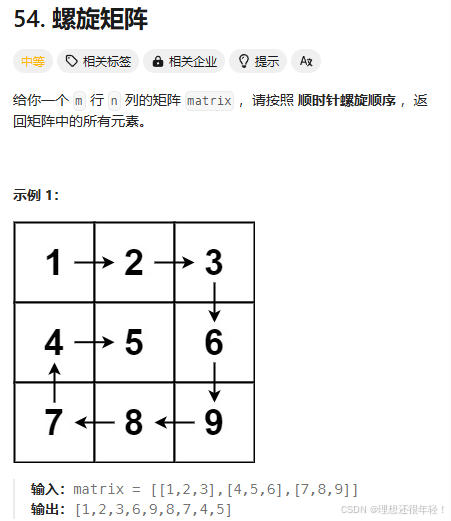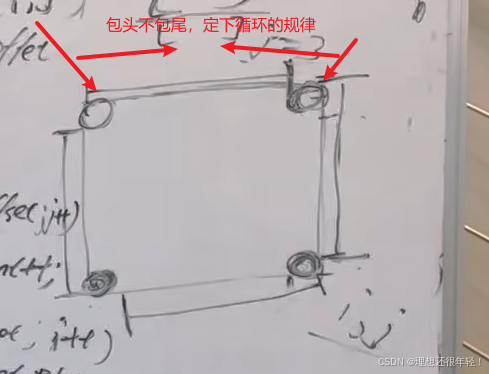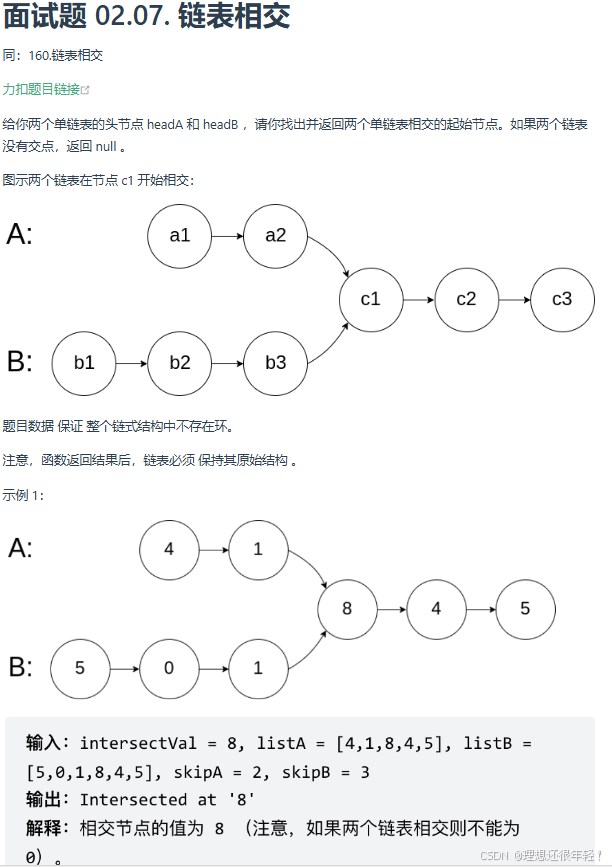阅读量:0
20240725
一、矩阵
54.螺旋矩阵(循环不变量)

一个矩阵,循环遍历出来,就得按照顺序去遍历,然后插到我们定义的矩阵里面去
class Solution { public int[][] generateMatrix(int n) { int[][] nums = new int[n][n];//定义一个矩阵 int startX = 0, startY = 0; // 每一圈的起始点 int offset = 1; int count = 1; // 矩阵中需要填写的数字 int loop = 1; // 记录当前的圈数 int i, j; // j 代表列, i 代表行; while (loop <= n / 2) { // 顶部 // 左闭右开,所以判断循环结束时, j 不能等于 n - offset for (j = startY; j < n - offset; j++) { nums[startX][j] = count++; } // 右列 // 左闭右开,所以判断循环结束时, i 不能等于 n - offset for (i = startX; i < n - offset; i++) { nums[i][j] = count++; } // 底部 // 左闭右开,所以判断循环结束时, j != startY for (; j > startY; j--) { nums[i][j] = count++; } // 左列 // 左闭右开,所以判断循环结束时, i != startX for (; i > startX; i--) { nums[i][j] = count++; } startX++; startY++; offset++; loop++; } if (n % 2 == 1) { // n 为奇数时,单独处理矩阵中心的值 nums[startX][startY] = count; } return nums; } } 二、链表
1 移除链表元素
1.1 原链表删除元素:
/** * 不添加虚拟节点and pre Node方式 * 时间复杂度 O(n) * 空间复杂度 O(1) * @param head * @param val * @return */ public ListNode removeElements(ListNode head, int val) { while(head!=null && head.val==val){//head!=null用于防止空指针错误,如果头节点就等于val的话 直接让头节点指向下一位。 head = head.next; } ListNode curr = head;//把头节点的位置拿到 while(curr!=null){//防止空指针 while(curr.next!=null && curr.next.val == val){//头指针的下一个也不为null,下一个为 val,那么我们的的next就要等于next.next了 curr.next = curr.next.next; } curr = curr.next;//把等于的值的curr返回。 } return head; } 1.2 虚拟头节点(!!!)
/** * 添加虚节点方式 * 时间复杂度 O(n) * 空间复杂度 O(1) * @param head * @param val * @return */ public ListNode removeElements(ListNode head, int val) { if (head == null) { return head; } // 因为删除可能涉及到头节点,所以设置dummy节点,统一操作 ListNode dummy = new ListNode(-1, head); ListNode pre = dummy; ListNode cur = head; while (cur != null) { if (cur.val == val) { pre.next = cur.next; } else { pre = cur; } cur = cur.next; } return dummy.next; } 2. 设计链表
//单链表 class ListNode { int val; ListNode next; ListNode(){} ListNode(int val) { this.val=val; } } class MyLinkedList { //size存储链表元素的个数 int size; //虚拟头结点 ListNode head; //初始化链表 public MyLinkedList() { size = 0; head = new ListNode(0); } //获取第index个节点的数值,注意index是从0开始的,第0个节点就是头结点 public int get(int index) { //如果index非法,返回-1 if (index < 0 || index >= size) { return -1; } ListNode currentNode = head; //包含一个虚拟头节点,所以查找第 index+1 个节点 for (int i = 0; i <= index; i++) { currentNode = currentNode.next; } return currentNode.val; } //在链表最前面插入一个节点,等价于在第0个元素前添加 public void addAtHead(int val) { addAtIndex(0, val); } //在链表的最后插入一个节点,等价于在(末尾+1)个元素前添加 public void addAtTail(int val) { addAtIndex(size, val); } // 在第 index 个节点之前插入一个新节点,例如index为0,那么新插入的节点为链表的新头节点。 // 如果 index 等于链表的长度,则说明是新插入的节点为链表的尾结点 // 如果 index 大于链表的长度,则返回空 public void addAtIndex(int index, int val) { if (index > size) { return; } if (index < 0) { index = 0; } size++; //找到要插入节点的前驱 ListNode pred = head; for (int i = 0; i < index; i++) { pred = pred.next; } ListNode toAdd = new ListNode(val); toAdd.next = pred.next; pred.next = toAdd; } //删除第index个节点 public void deleteAtIndex(int index) { if (index < 0 || index >= size) { return; } size--; if (index == 0) { head = head.next; return; } ListNode pred = head; for (int i = 0; i < index ; i++) { pred = pred.next; } pred.next = pred.next.next; } } //双链表 class ListNode{ int val; ListNode next,prev; ListNode() {}; ListNode(int val){ this.val = val; } } class MyLinkedList { //记录链表中元素的数量 int size; //记录链表的虚拟头结点和尾结点 ListNode head,tail; public MyLinkedList() { //初始化操作 this.size = 0; this.head = new ListNode(0); this.tail = new ListNode(0); //这一步非常关键,否则在加入头结点的操作中会出现null.next的错误!!! head.next=tail; tail.prev=head; } public int get(int index) { //判断index是否有效 if(index<0 || index>=size){ return -1; } ListNode cur = this.head; //判断是哪一边遍历时间更短 if(index >= size / 2){ //tail开始 cur = tail; for(int i=0; i< size-index; i++){ cur = cur.prev; } }else{ for(int i=0; i<= index; i++){ cur = cur.next; } } return cur.val; } public void addAtHead(int val) { //等价于在第0个元素前添加 addAtIndex(0,val); } public void addAtTail(int val) { //等价于在最后一个元素(null)前添加 addAtIndex(size,val); } public void addAtIndex(int index, int val) { //index大于链表长度 if(index>size){ return; } //index小于0 if(index<0){ index = 0; } size++; //找到前驱 ListNode pre = this.head; for(int i=0; i<index; i++){ pre = pre.next; } //新建结点 ListNode newNode = new ListNode(val); newNode.next = pre.next; pre.next.prev = newNode; newNode.prev = pre; pre.next = newNode; } public void deleteAtIndex(int index) { //判断索引是否有效 if(index<0 || index>=size){ return; } //删除操作 size--; ListNode pre = this.head; for(int i=0; i<index; i++){ pre = pre.next; } pre.next.next.prev = pre; pre.next = pre.next.next; } } 206. 反转链表(双向指针和递归)
双指针
给你单链表的头节点 head ,请你反转链表,并返回反转后的链表。
class Solution { public ListNode reverseList(ListNode head) { ListNode cur=head; ListNode prev=null; ListNode temp=null; while(cur != null){ temp=cur.next;//上面这俩位置是把拿到的值拼凑到一起 cur.next=prev; prev=cur;//下面这俩位置,是用来去拿数的 cur=temp; } return prev; } } 递归
// 递归 class Solution { public ListNode reverseList(ListNode head) { return reverse(null, head); } private ListNode reverse(ListNode prev, ListNode cur) { if (cur == null) { return prev; } ListNode temp = null; temp = cur.next;// 先保存下一个节点 cur.next = prev;// 反转 // 更新prev、cur位置 // prev = cur; // cur = temp; return reverse(cur, temp); } } 交换链表中的元素
虚拟头节点法
class Solution { public ListNode swapPairs(ListNode head) { ListNode dumyhead = new ListNode(-1); // 设置一个虚拟头结点 dumyhead.next = head; // 将虚拟头结点指向head,这样方便后面做删除操作 ListNode cur = dumyhead; ListNode temp; // 临时节点,保存两个节点后面的节点 ListNode firstnode; // 临时节点,保存两个节点之中的第一个节点 ListNode secondnode; // 临时节点,保存两个节点之中的第二个节点 while (cur.next != null && cur.next.next != null) { temp = cur.next.next.next; firstnode = cur.next; secondnode = cur.next.next; cur.next = secondnode; // 步骤一 secondnode.next = firstnode; // 步骤二 firstnode.next = temp; // 步骤三 cur = firstnode; // cur移动,准备下一轮交换 } return dumyhead.next; } } 递归法
// 递归版本 class Solution { public ListNode swapPairs(ListNode head) { // base case 退出提交 if(head == null || head.next == null) return head; // 获取当前节点的下一个节点 ListNode next = head.next; // 进行递归 ListNode newNode = swapPairs(next.next); // 这里进行交换 next.next = head; head.next = newNode; return next; } } 删除链表的倒数第N个节点
class Solution { public ListNode removeNthFromEnd(ListNode head, int n) { //新建一个虚拟头节点指向head ListNode dummyNode = new ListNode(0); dummyNode.next = head; //快慢指针指向虚拟头节点 ListNode fastIndex = dummyNode; ListNode slowIndex = dummyNode; // 只要快慢指针相差 n 个结点即可 for (int i = 0; i <= n; i++) { fastIndex = fastIndex.next; } while (fastIndex != null) { fastIndex = fastIndex.next; slowIndex = slowIndex.next; } // 此时 slowIndex 的位置就是待删除元素的前一个位置。 // 具体情况可自己画一个链表长度为 3 的图来模拟代码来理解 // 检查 slowIndex.next 是否为 null,以避免空指针异常 if (slowIndex.next != null) { slowIndex.next = slowIndex.next.next; } return dummyNode.next; } } 142. 环形链表 II
给定一个链表的头节点 head ,返回链表开始入环的第一个节点。 如果链表无环,则返回 null。
如果链表中有某个节点,可以通过连续跟踪 next 指针再次到达,则链表中存在环。 为了表示给定链表中的环,评测系统内部使用整数 pos 来表示链表尾连接到链表中的位置(索引从 0 开始)。如果 pos 是 -1,则在该链表中没有环。注意:pos 不作为参数进行传递,仅仅是为了标识链表的实际情况。
不允许修改 链表。
ListNode slow = head; ListNode fast = head; while (fast != null && fast.next != null) { slow = slow.next; fast = fast.next.next; if (slow == fast) {// 有环 ListNode index1 = fast; ListNode index2 = head; // 两个指针,从头结点和相遇结点,各走一步,直到相遇,相遇点即为环入口 while (index1 != index2) { index1 = index1.next; index2 = index2.next; } return index1; } } return null; } } 链表相交(学习思路)

(版本一)先行移动长链表实现同步移动 public class Solution { public ListNode getIntersectionNode(ListNode headA, ListNode headB) { ListNode curA = headA; ListNode curB = headB; int lenA = 0, lenB = 0; while (curA != null) { // 求链表A的长度 lenA++; curA = curA.next; } while (curB != null) { // 求链表B的长度 lenB++; curB = curB.next; } curA = headA; curB = headB; // 让curA为最长链表的头,lenA为其长度 if (lenB > lenA) { //1. swap (lenA, lenB); int tmpLen = lenA; lenA = lenB; lenB = tmpLen; //2. swap (curA, curB); ListNode tmpNode = curA; curA = curB; curB = tmpNode; } // 求长度差 int gap = lenA - lenB; // 让curA和curB在同一起点上(末尾位置对齐) while (gap-- > 0) { curA = curA.next; } // 遍历curA 和 curB,遇到相同则直接返回 while (curA != null) { if (curA == curB) { return curA; } curA = curA.next; curB = curB.next; } return null; } } (版本二) 合并链表实现同步移动 public class Solution { public ListNode getIntersectionNode(ListNode headA, ListNode headB) { // p1 指向 A 链表头结点,p2 指向 B 链表头结点 ListNode p1 = headA, p2 = headB; while (p1 != p2) { // p1 走一步,如果走到 A 链表末尾,转到 B 链表 if (p1 == null) p1 = headB; else p1 = p1.next; // p2 走一步,如果走到 B 链表末尾,转到 A 链表 if (p2 == null) p2 = headA; else p2 = p2.next; } return p1; } } 